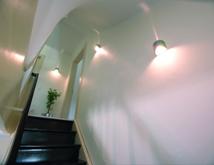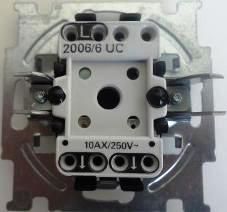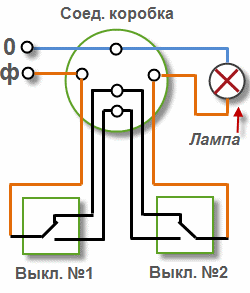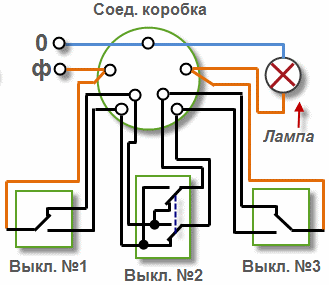Categories: Practical Electronics, Novice electricians, Electrician at home, Sockets and switches
Number of views: 2016012
Comments on the article: 60
Feedthrough switch. Wiring diagram
 Circuit-breaker circuits allow turning on and off the lighting from two or more different places of their installation. In some cases, this is not only convenient, but also very necessary.
Circuit-breaker circuits allow turning on and off the lighting from two or more different places of their installation. In some cases, this is not only convenient, but also very necessary.
For example, the room has a long corridor. It is naturally lit. Turning on the light at the beginning, and having this circuit breaker connection diagram, you don’t have to come back again to turn off, but you can do it with the second switch that is installed at the other end of the corridor. Very often, such schemes are also used to control the lighting of stairs.
Which is better to use: loop-through switches or bistable relays? Answer here.
How to connect pass-through switches for independent control of lighting from two places.
Let's take a closer look at this wiring diagram consisting of two loop-through switches. It will require two switches (they are also called “pass-through”), each of which has three contacts and two switching positions. Moreover, the switching mode must be of "cross over nature", that is - one contact is common to the other two. In one position it is closed with one of them, and in another position, naturally, with another. Consequently, the general isolation of all three contacts is completely excluded.
Connection diagram of a passage switch for controlling a lamp from 2 places

Three-way and two-way switch through passage (on top is a common contact)
Explanations for the schemes
Now let's figure out the drawn diagrams. Both schemes consist of junction box, passage switches themselves, a lamp and connecting wires (during installation, these will be two, three and four-core cables). The first diagram shows wiring diagram for the through switch with control from two different places.
As you can see, one wire (in our case it is zero) goes from the power source to the junction box and from it to the lamp. Another (phase wire), after the box is connected to the common contact of one of the switches. Two switched contacts of one switch are connected to two contacts of the second switch (through the box). Well, with the common contact of the second switch, the phase is fed to the second contact of the lamp.
As for the installation of this scheme itself: they are put in their installation places breakersfrom which three-core cables are output. Lamps are mounted that will be connected in parallel and from which as a result a two-core cable comes out.
Further, a junction box is installed in the most suitable place (taking into account the minimum cable length and a convenient location for the location of this box). The cable from the fixtures, the power supply and the passage switches themselves is introduced into it. This box is made wire connection among themselves, as shown in the diagram.
Connection diagram of a through switch for controlling a lamp from 3 places
How to control lighting from three places
Three-place control circuit breaker connection diagram not much different from the previous one (the general principle of operation is the same). It added another pass-through switch, which is slightly different from the previous ones. As can be seen from the diagram, this twin switch. That is, when one key is pressed, the two contacts are simultaneously thrown over electrically independent of each other. In addition, as you should have noticed, a four-wire cable comes out of it.
The connection diagrams of through-passage switches of this type are good in that they are relatively simple in their design (no additional components are required). But they are limited by the number of such control places.
The task of independent lighting control from two places can also be solved using special impulse relays and blocks for remote lighting control.
Other ways to implement lighting control from two or more places:
Schematic and wiring diagrams of lighting in an apartment and a house
See also:
Design and principle of operation of switches and switches of various kinds
Selected articles on the topic "Lighting control in the house"
See also at e.imadeself.com
:



# 22 wrote: | [quote]
I did not know anything about pass-through switches, but I accidentally made it from an old Soviet switch. And he did it simply: on the key, inside there is a plate. I carefully removed it, and on the other side fixed the contact (removed from the old relay). On the switch housing underneath on a small bolt, fixed a plate for attaching the wire